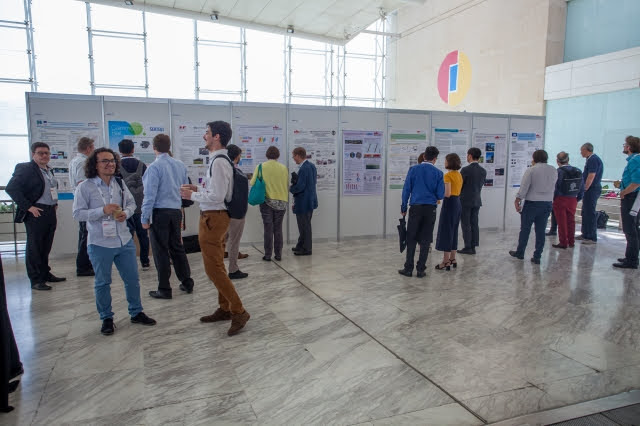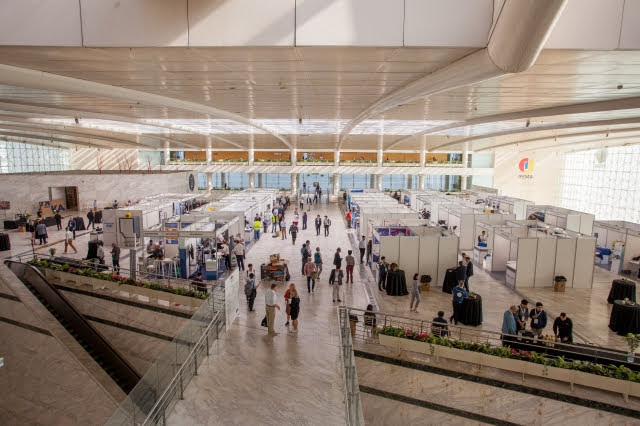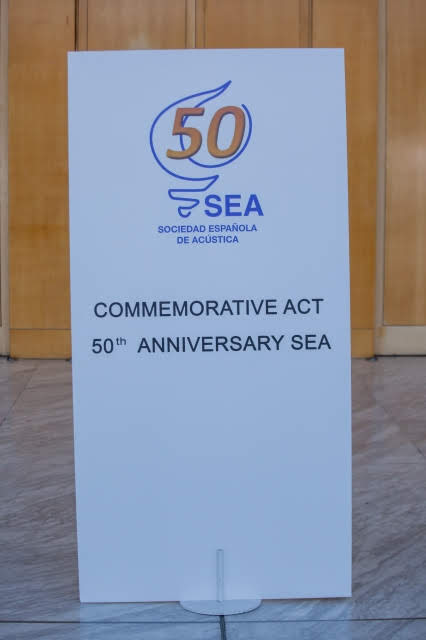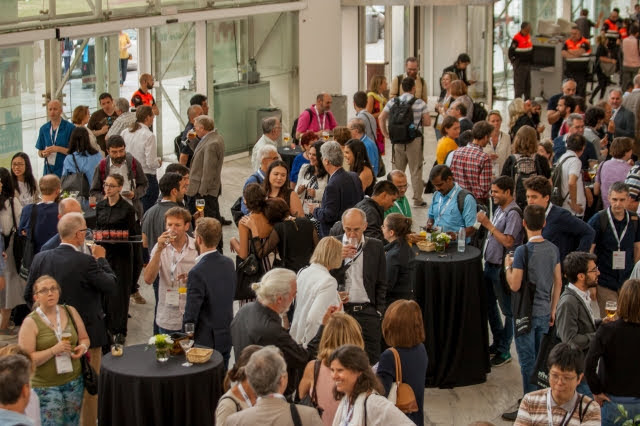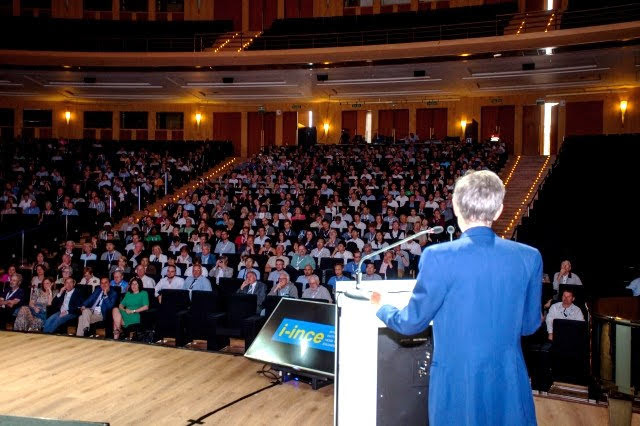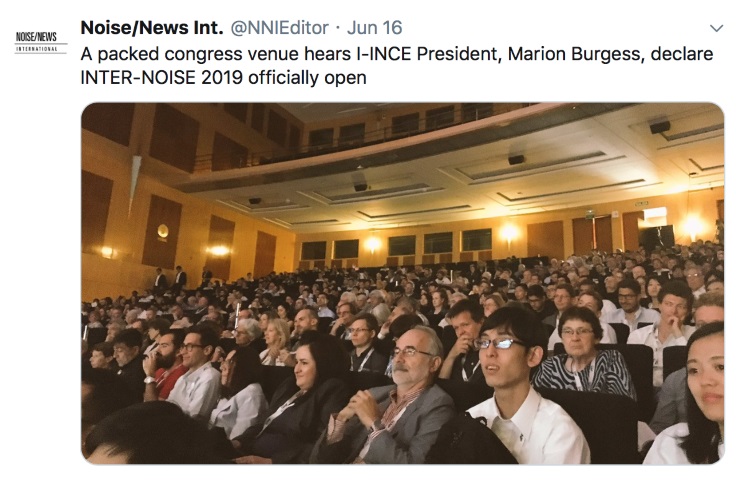INTER-NOISE 2019 Report
INTER-NOISE 2019, the 48th International Congress and Exposition on Noise Control Engineering, organized by the Spanish Acoustical Society (SEA) on behalf I-INCE, was held June 16–19, 2019, at the IFEMA Palacio Municipal, in Madrid, Spain.
With 1,188 delegates in attendance, the conference saw 815 oral technical presentations and 79 poster presentations, from a total of 2,925 authors spread over 95 technical sessions. While organizing a conference of this size requires time and help from many individuals, the principal congress organizers were Antonio Perez-Lopez (congress president), Jorge Patricio (congress vice president), and Antonio Calvo-Manzano (general secretary, proceedings editor). Also assisting with the organization and administration of the conference were J. Salvador Santiago (technical program committee chair, proceedings editor); Luigi Maffei (technical program committee chair); Ana Delgado (proceedings editor); and Joan Casamajo, Ana Espinel, Harald Muñoz, Castor Rodriguez, Jose Maria Ruiz (exhibition committee). The exhibition hall saw 55 exhibitors representing 61 companies over a total of 63 separate stands.
This year, the theme of the conference was “Noise Control for a Better Environment,” and contributions came from over 60 countries around the world. As luck would have it, it was quite appropriate to have INTER-NOISE in Madrid this year, as the congress was also an opportunity to celebrate the 50th anniversary of the host society, the Spanish Acoustical Society.
Opening the Conference, Sunday, June 16
The opening events for the conference were held on Sunday afternoon, June 16. In the opening ceremony, congress president and SEA president Antonio Pérez-Lopez welcomed all the attendees to the congress and to the city of Madrid. He expressed his gratitude to all involved and promised four days where we would share the most advanced research on noise control and its different technologies. He also explained that the Madrileños are sometimes called “cats”; they enjoy a night out, but they do so quietly and enjoy the night without bothering anyone. He invited all attendees to do the same—enjoy Madrid late but don’t make any disturbing noise!
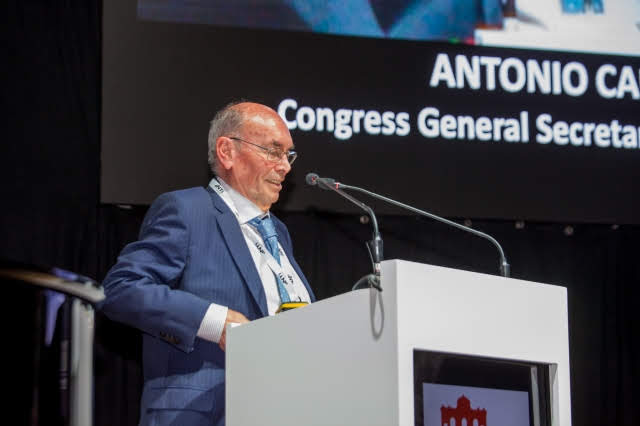
There followed presentations from the congress technical chair, José Salvador Santiago Páez, and the vice president of the I-INCE for technical activities, Patricia Davies. After these remarks, there were special presentations of the Caracola SEA, the highest award of the SEA. This year’s awardees included Marion Burgess, I-INCE president; Joachim Scheuren, I-INCE past president; Antonio Pérez-López, SEA president; and the I-INCE itself. I-INCE received the award in recognition of the important contributions the institute has made in promoting noise control all over the world through the organization of the INTER-NOISE congresses.
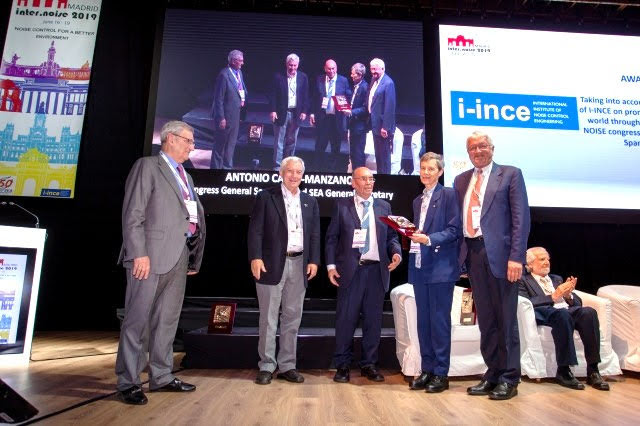
The president of I-INCE, Marion Burgess, then took the stage to welcome everyone to Madrid and declare the congress officially open.
The first plenary lecture was delivered by Ines López Arteaga, from the Eindhoven University of Technology and the Royal Institute of Technology of Sweden. The topic of her talk was “Rolling Noise in Road and Rail Transportation Systems.” She noted that “long term exposure to ground transportation (road and rail traffic) noise is, after air pollution, the main environment-related health stressor in densely populated areas and compromises the quality of life and, indirectly, the life expectations of millions of people.” In an interactive presentation, she frequently asked the audience questions and invited people to stand or sit if they agreed or disagreed with a specific statement. Using a roving microphone, she then delved deeper into the viewpoints of various audience members.
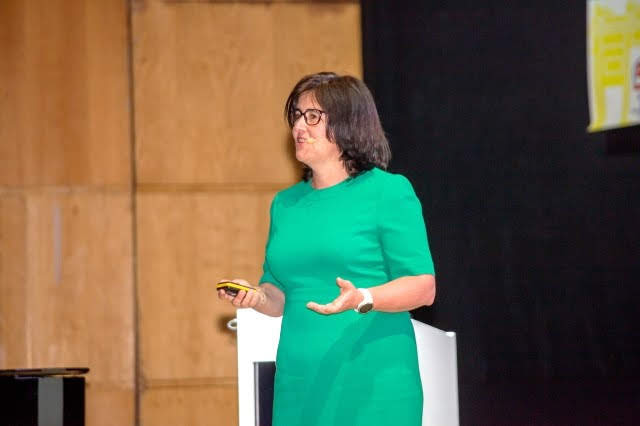
After this presentation, the audience was treated to a performance from the choir of the Polytechnic University of Madrid, which performed pieces from the golden century of Spanish music, works based on Spanish literature, and fragments of zarzuelas. The activities concluded with a tapas and cocktail reception.
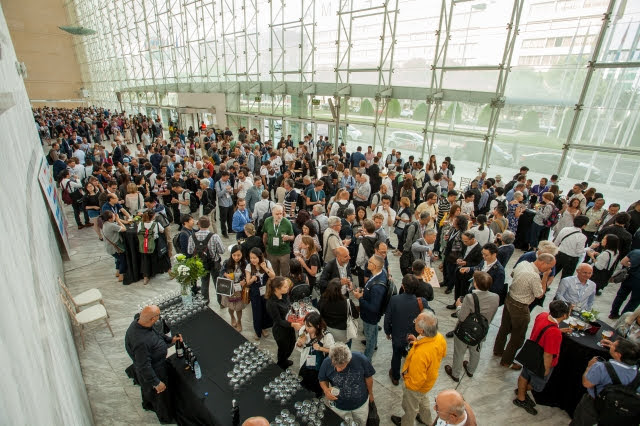
Monday, June 17
The technical program began on Monday, June 17. The day began with 19 parallel sessions covering a wide array of topics, from community noise to artificial intelligence.
The day also saw a keynote lecture from Stephen A. Hambric, from Penn State’s Center for Acoustics and Vibration. The title of his talk was “To Infinity and Beyond—The Amazing Uses of Infinite Structure Mobility Theory.” He started by asking, “What if there were simple formulae you could use to calibrate structural mobility measurements on beams, plates, pipes, large pressure vessels, aircraft fuselages, and other structures? What if those same formulae could be used to estimate the mobilities of structures that haven’t been built? How about using them to estimate how mobility might change if you modify the material properties of an existing structure? Great news—these formulae exist, are simple enough to code in a spreadsheet in minutes, and are perhaps the most invaluable tools a structural-acoustician has.” Great news indeed, and what followed was a great presentation on infinite structure mobility theory.
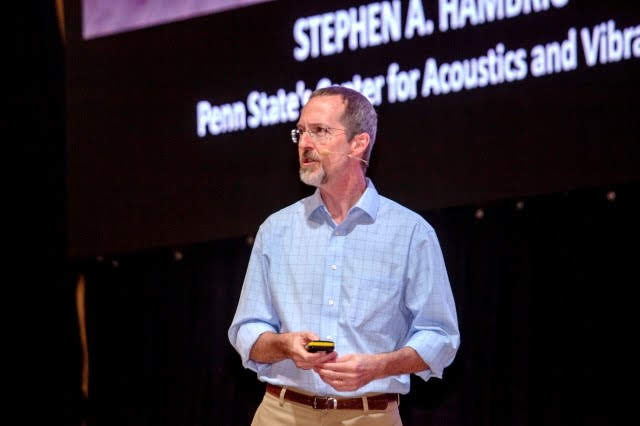
The encouragement of young professionals is vitally important, and in recognition of this, I-INCE funds a number of Young Scientists Grants to assist with participation at each congress. On Monday afternoon, the I-INCE Young Professional Workshop was held and was followed by the presentation of travel awards and a social networking hour. The goals of the Young Professional Practice School are to provide mentorship via case studies and professional issues presented by world-renowned experts and to hold informal discussions between young professionals and I-INCE leaders and senior noise control engineers.
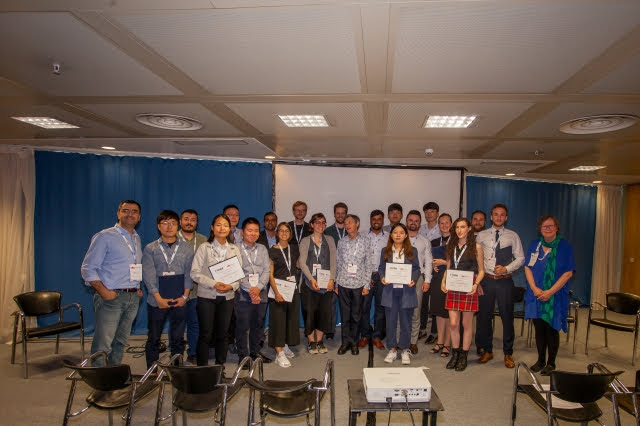
Tuesday, June 18
The congress continued on Tuesday and opened with 18 parallel technical sessions covering a wide range of topics. Both the technical sessions and the exhibition continued through this day. There was active participation in both with many excellent papers. The plenary lecture for this day was delivered by Jun Yang, from the Chinese Academy of Sciences (CAS), University of Chinese Academy of Sciences (UCAS), and the director of the Key Laboratory of Noise and Vibration Research at CAS. The title of his talk was “Sound Zone Reproduction Using Loudspeaker Array.” The talk considered the reproduction of a desired sound field over a target region, which is a hot topic in the research area of the spatial audio. This presentation proposed a framework for a robust sound field reproduction design, which would allow a physical perspective on the regularization required for a system, increase robustness of the SFR systems against perturbations, and simplify the SFR system design.
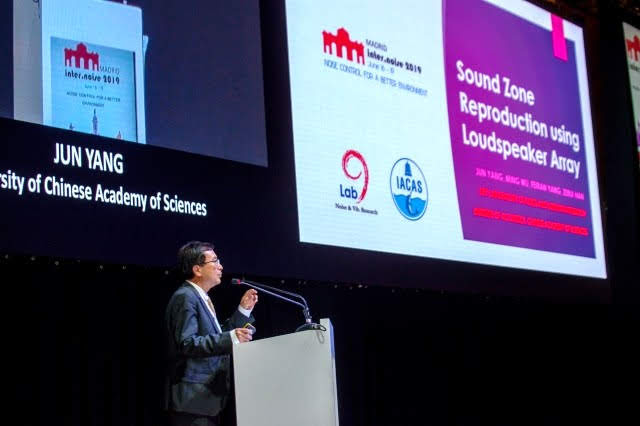
On Tuesday evening, an event to celebrate the 50th anniversary of the founding of the Spanish Acoustic Society took place. A number of awards were presented to deserving individuals during the event, including the Caracola SEA to Emilio Lora-Tamayo, who delivered a speech covering the history of the SEA over the last 50 years. The EEA, I-INCE, and the ICA all sent their well wishes and congratulated the SEA on its many achievements since its founding in 1969.
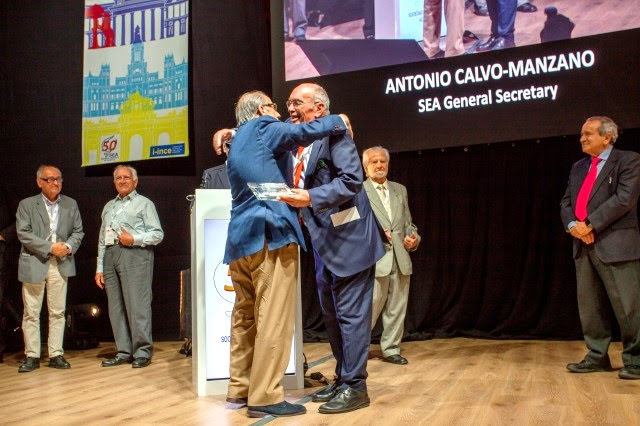
Wednesday, June 19
Technical sessions continued until lunchtime on Wednesday and ended with the final plenary lecture, delivered by André Fiebig, from Technische Universität Berlin, titled “The Perception of Acoustic Environments and How Humans Form Overall Noise Assessments.” He noted that, because of the omnipresence of noise, the perception of noise has a strong impact on the well-being and life quality of human beings. The talk outlined the basics of perception and presented some insights into the complex mechanisms of forming overall noise assessments. Those insights are relevant for the fields of psychoacoustics and soundscape or even the experience of product sound quality and might be helpful to effectively protect humans from nuisance and adverse health effects.
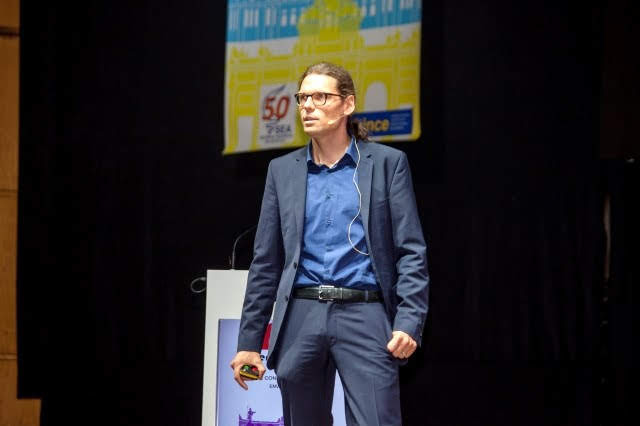
The closing ceremony was held on Wednesday afternoon. Antonio Pérez-López thanked all those present for attending the congress and congratulated all on the quality of the papers presented. I-INCE president Marion Burgess declared the closing of INTER-NOISE 2019, and the ceremony concluded with an invitation to Seoul for INTER-NOISE 2020.
